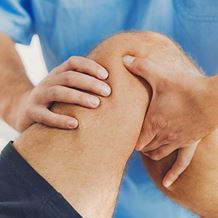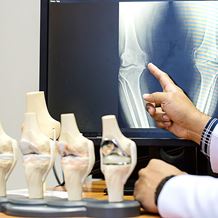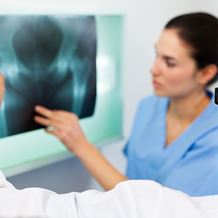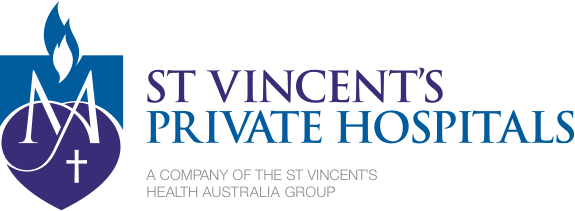Recovery exercises: Knee replacement surgery
- Home
- Services
- Orthopaedics
- Knowledge Hub
- Recovery exercises: Knee replacement surgery
Restoring your muscle strength and range of knee movement is important to a full recovery after single or bilateral knee replacement surgery.
An individual assessment will determine the most appropriate rehabilitation program to suit your needs. An individual assessment will help to determine the most appropriate program, a process that is unique to each patient.
Following surgery there are several therapy options Including rehabilitation in the home (visiting physiotherapist), inpatient rehabilitation, outpatient program +/- hydrotherapy. This will vary between our hospitals, so please discuss what is most appropriate for you on admission to hospital.
Post-surgical exercises
Recovery exercises are an important part of the healing process and should be started as soon as possible. During your hospital stay you will be shown exercises to strengthen and improve the range of movement in your knee. Continue your prescribed exercises at home. Your physiotherapist will advise and show you how to progress your exercises. Aim to complete these exercises 3-4 times a day or as instructed by your physiotherapist.
Stationary knee exercises
Add resistance weights to these exercises as you become more comfortable with them.
Static quadriceps activation and calf stretch: 10 reps
Sitting comfortably on your bed with your legs stretched out in front of you, place a bandage around your foot and tighten your front thigh muscle. Push your knee down into the bed and gently pull on the bandage to stretch your calf at the same time. Hold this stretch for up to 10 seconds before relaxing and repeating.


Heel slide: 10 reps
This exercise helps increase the flexion of your knee. Slide your heel up the bed towards you, bending your knee as much as possible as you go. Gently slide your leg back down the bed before repeating.
Inner range quadriceps: 10 reps
Sit up in bed and rest your knee on a rolled towel or foam roller for support. Keeping your thigh resting on the bolster, lift your heel off the bed to straighten your knee pulling your toes towards you. Hold for 3 seconds before lowering your leg back down. If this movement is too painful, you can start out by using a belt to help lift your leg to help.


Straight leg raises: 10 reps
Lie back somewhere comfortable with your leg fully straightened. Tighten up your thigh muscle and lift your leg several inches above the bed. Hold it here for up to 10 seconds before slowly lowering down back to the bed.
Ankle pumps: 10-15 reps each leg
Ankle pump exercises help stimulate the blood flow in the lower leg, which improves the circulation as well as strengthens the muscles. Lie down with your legs extended and keep one foot propped up with a towel under the ankle. Flex your foot by pushing the heel away from your body, with your toes pointing back towards your body. Hold this position for 5 seconds before reversing the movement and pointing your toes away from your body. Draw your heel in towards your calf muscle and hold for a further 5 seconds. Repeat before swapping to the other leg.

Knee straightening: 10 reps
Place a small rolled towel under your foot just above the heel, so that your heel is no longer touching the bed. Now tighten up your thigh muscle and try to fully straighten your knee so that the back of your knee touches the bed. Hold this position for up to 3-5 seconds, before releasing and repeating.

Knee bends: 10 reps
These can be performed in several different positions and will help improve the range of motion in your knee.
Bed-supported
Lie on the bed with your knee straight in front of you. Keeping your heel on the bed, slowly bend your knee and slide your heel towards your bottom as far as you find comfortable. Hold for 3-5 seconds. Slowly slide your heel back down the bed. Repeat.
Seated
These are both seated exercises but different variations/options
In a seated position, bend your operated knee as far back as you can. You can increase the range and stretch by placing the opposite foot in front of the foot on your operated side and pushing back further. Alternatively, you can lean or slide your upper body forward. Hold for 3-5 seconds, return back to resting position then repeat.
Standing knee lifts
Stand upright using a kitchen bench or rail for support. Slowly lift your knee up as far as you can. Hold 3-5 seconds then lower. Repeat.
Standing knee bends
Standing upright using a kitchen bench or rail for support. Slowly bend your knee backwards towards your bottom. Hold for 3-5 seconds then lower.
Active exercises

Walking: 2 outings per day building up from 10-30 minutes
Early activity is known to help your knee recover more quickly as well as restore strength and movement, and walking is a great way to achieve this. It is likely you will need crutches or a walker to help you move around, if that is the case, your physiotherapist will guide you how to walk with these.
You will start with shorter walks multiple times a day before progressing your distance. Your physiotherapist will progress you off crutches as appropriate.
Stationary cycling:
10-15 minutes, twice daily
This is an excellent activity to help regain knee mobility and muscle strength by building up the supporting muscles around the knee. When you first begin, adjust the seat height so that your knee is almost entirely straight, and start out by pedalling back and forth. Once this movement is comfortable, you can pedal forwards and slowly increase the resistance as you improve.


Hydrotherapy
Exercising in water helps alleviate any strain on your joints and permits a greater range of movement with minimal pain. The warm water relaxes the muscles allowing them to stretch and lengthen as well as providing a natural resistance that improves strength and mobility. The buoyancy can also help patients to feel more confident in their movement. Hydrotherapy is usually available to patients around 3 weeks after surgery, once the wound has fully healed, however, please check with your surgeon prior to commencing
It’s important to remember that your hips will not stay at their current level of function without maintaining regular exercise. Your mobility and flexibility will gradually decrease. Following a rehabilitation program for the first 6 months after surgery will give your new hip the best chance of achieving its maximum potential. If you notice any change in your flexibility or range of movement, contact your surgeon straight away.
Related Content

Total Knee Replacement Surgery – Your Recovery
The recovery after knee replacement will be different for every patient.
Read More
Knee Replacement
The knee joint is one of the largest and most complex joints in the body.
Read More
Find a Specialist
Talk to our world-leading orthopaedic specialists about the most suitable treatment options.
Read More